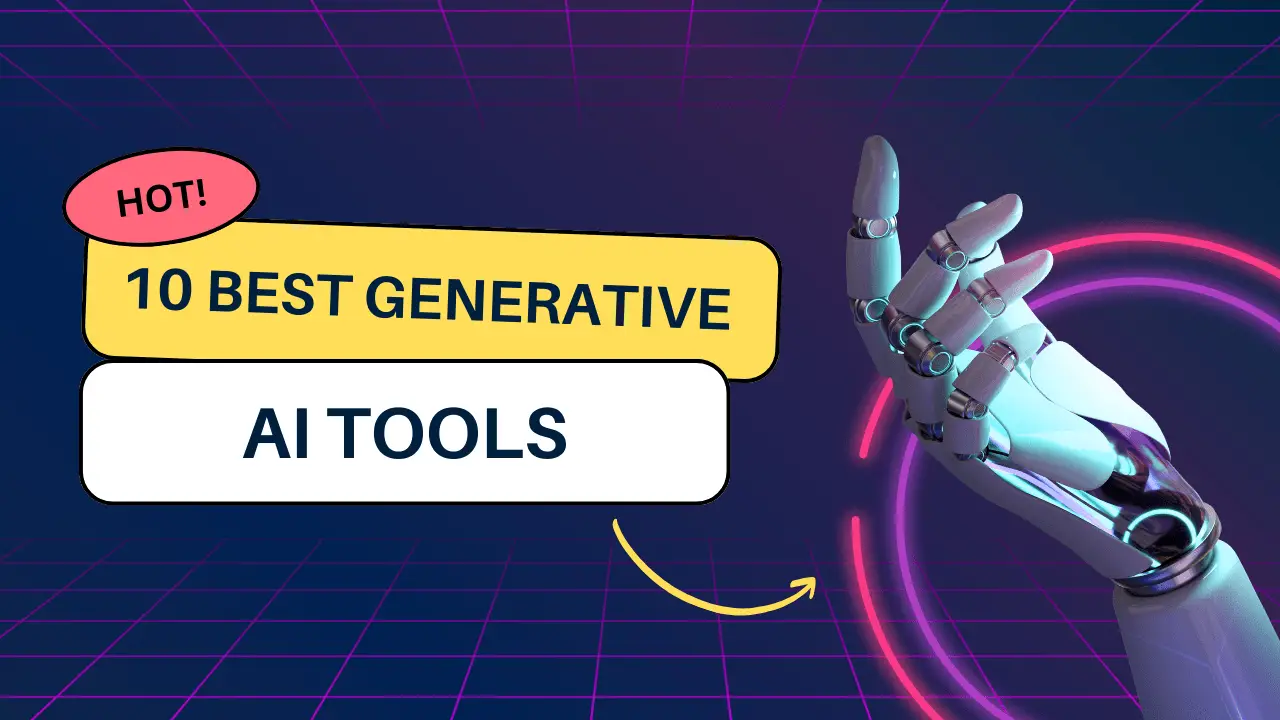
Last Updated on October 28, 2023 by Ajay Kumar
In today’s evolving landscape, where creativity seamlessly merges with automation, the Best Generative AI Tools represent a pinnacle in the integration of artificial intelligence and human ingenuity, unlocking a realm of limitless possibilities. Whether you’re an author seeking inspiration, a designer in need of fresh concepts, or a developer in pursuit of efficient solutions, the intersection of technology and imagination has ushered in a surge of generative AI tools.
These tools go beyond being mere algorithms; they are forward-thinking companions, ready to enhance your creative and technical pursuits. In this article, we embark on a journey to explore the top 10 generative AI tools that demand the attention of writers, designers, and developers alike. Join us as we delve into this thrilling landscape where machines assume the role of co-creators, pushing the boundaries of innovation and revolutionizing the way we approach our creative endeavours.
Before going through the list of 10 Best Generative AI Tools, let’s see what we actually mean by Geneartiove AI, How you can use them, and what are the benefits of Generative AI Tools.
What are generative AI tools?
Generative AI tools are a type of artificial intelligence (AI) that can create new and original content, such as text, images, music, code, and video. These tools are trained on large datasets of existing content, and they use this data to learn how to generate new content that is similar to the data they were trained on.
Generative AI tools are still under development, but they have the potential to revolutionize many industries. For example, they can be used to:
- Create more engaging and personalized marketing materials
- Generate new ideas for products and services
- Automate tasks that are currently done by humans
- Develop new forms of creative expression
Here are some examples of generative AI tools:
- Text generation: GPT-3, Jasper, Bard, Copy.ai, Wordtune
- Image generation: DALL-E 2, Midjourney, Imagen, Parti
- Music generation: MuseNet, Jukebox, Amper
- Code generation: GitHub Copilot, Tabnine, Kite, Copilot.ai
- Video generation: DeepFaceLab, Synthesia, Runway ML
Generative AI tools represent a potent emerging technology that holds the promise of reshaping our daily lives and professional endeavours. As these tools advance, we anticipate witnessing their deployment in increasingly imaginative and pioneering manners.
Certain individuals harbour reservations regarding the likelihood of generative AI tools being employed to generate detrimental content, including false information or deceptive multimedia. Nonetheless, it’s crucial to keep in mind that generative AI tools are essentially instruments, and their ethical application ultimately depends on us. The responsibility falls upon us to employ these tools conscientiously and in a morally upright manner.
10 The Best Generative AI Tools

ChatGPT
ChatGPT, a substantial language model chatbot, was created by OpenAI and made available on November 30, 2022. It is closely related to InstructGPT, a model designed to comprehend prompts and deliver comprehensive responses. ChatGPT has been trained on an extensive corpus of text and code, enabling it to perform a variety of tasks, including generating text, translating languages, composing diverse forms of creative content, and furnishing informative answers to your queries. Since its launch, ChatGPT has somewhat the first preference of many as the Best generative AI tools available in 2023.
Use cases of ChatGPT
ChatGPT can be used for a variety of purposes, including:
- Customer service: ChatGPT can be used to create chatbots that can answer customer questions and provide support. This can free up human customer service representatives to focus on more complex issues.
- Education: ChatGPT can be used to create personalized learning experiences for students. For example, it can be used to generate practice problems or to provide feedback on student writing.
- Entertainment: ChatGPT can be used to create chatbots that can have engaging conversations with people. This can be used for entertainment purposes, such as creating chatbots that can tell stories or play games.
Features of ChatGPT
ChatGPT has several features that make it a powerful tool, including:
- Human-quality text generation: ChatGPT can generate text that is indistinguishable from human-written text. This makes it ideal for use cases such as customer service and education.
- Ability to have engaging conversations: ChatGPT can have engaging conversations with people. This is because it is trained on a massive dataset of text and code, which gives it a deep understanding of human language.
- Ability to learn and adapt: ChatGPT can learn and adapt over time. This means that it can be used for new and innovative purposes as it continues to develop.
Pros and Cons of ChatGPT
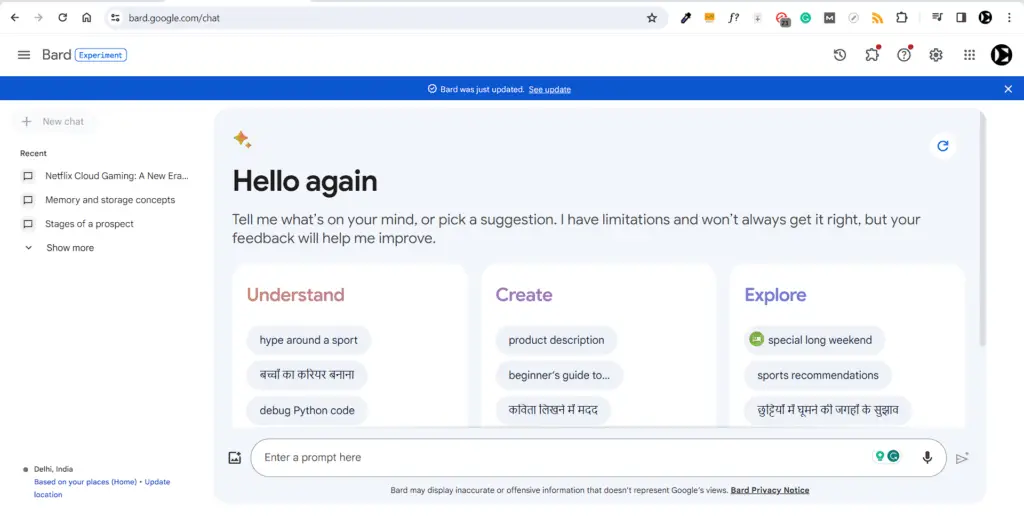
Bard
Google Bard, a substantial language model, often referred to as a conversational AI or chatbot, is specifically engineered to deliver comprehensive and informative responses. This AI entity has undergone extensive training on an immense volume of text data, enabling it to engage in human-like text generation when confronted with various prompts and inquiries. For instance, Bard is proficient at offering factual topic summaries and crafting narratives, which is the reason for the rapidly increasing popularity of Bard as one of the Best Generative AI Tools.
Google Bard Use Cases
Here are some examples of how Google Bard can be used:
- Generating creative content: Bard can be used to generate different creative text formats of text content, like poems, code, scripts, musical pieces, emails, letters, etc.
- Simplifying complex topics: Bard can be used to simplify complex topics, like explaining discoveries from NASA’s James Webb Space Telescope to a 9-year-old.
- Answering questions in an informative way: Bard can be used to answer questions in an informative way, even if they are open-ended, challenging, or strange.
- Brainstorming ideas: Bard can be used to brainstorm ideas and spark creativity.
- Accelerating productivity: Bard can be used to accelerate productivity by performing tasks such as summarizing documents, generating reports, and creating presentations.
Google Bard Features
Here are some of the features of Google Bard:
- Generative: Bard can generate text, translate languages, write different kinds of creative content, and answer your questions in an informative way.
- Comprehensive: Bard has access to a massive amount of information from the web and can use this information to provide comprehensive and informative responses to your questions.
- Informative: Bard is trained to be informative and comprehensive and will try its best to provide accurate and helpful information in response to your questions.
- Safe: Bard is designed to be safe and grounded in real-world information. It will not generate harmful or unsafe content.
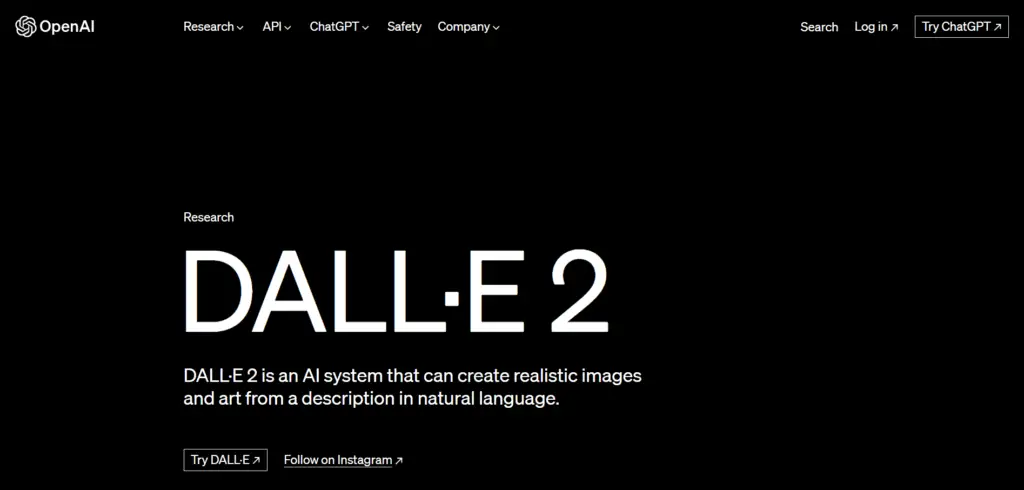
DALL-E 2
DALL-E 2 is a substantial language model chatbot, with its primary purpose being the generation of lifelike images and artistic creations based on textual descriptions. This innovative tool holds great promise for creative experts, including designers, artists, and writers. While DALL-E 2 is currently in the development phase, its future impact on the creation and consumption of visual content could be revolutionary and could make it one of the Best Generative AI Tools out there.
DALL-E 2 Use Cases
Here are some examples of how DALL-E 2 can be used:
- Generating realistic images and art: DALL-E 2 can generate realistic images and art from a text description. This can be useful for creating marketing materials, concept art, or simply for fun.
- Creating new products and designs: DALL-E 2 can be used to create new products and designs. For example, a designer could use DALL-E 2 to generate ideas for new clothing designs or furniture.
- Prototyping and testing new ideas: DALL-E 2 can be used to prototype and test new ideas. For example, a company could use DALL-E 2 to generate prototypes of new product packaging or marketing materials.
- Educating and informing: DALL-E 2 can be used to educate and inform people. For example, a teacher could use DALL-E 2 to generate images and illustrations to help students learn about different topics.
DALL-E 2 Features
Here are some of the features of DALL-E 2:
- Generative: DALL-E 2 can generate realistic images and art from a text description.
- High quality: DALL-E 2 generates high-quality images that are often indistinguishable from real photographs.
- Variety: DALL-E 2 can generate a wide variety of images, from realistic photos to abstract art.
- Creativity: DALL-E 2 can be used to generate creative and original images.
Pros and Cons of DALL-E 2

AlphaCode
AlphaCode, a code generation AI model engineered by DeepMind, stands as a substantial language model (LLM) proficient in producing code in ten programming languages, including Python, C++, and Java. While AlphaCode remains in the developmental phase, it has already demonstrated its capability to generate code of a quality comparable to that crafted by human programmers, which put other competitors in a tough spot in the race to become the best Generative AI Tools for programmers.
AlphaCode Use Cases
Here are some examples of how AlphaCode can be used:
- Coding assistance: AlphaCode can be used to assist programmers with tasks such as code completion, code generation, and bug fixing. This can help programmers to be more productive and to write higher-quality code.
- Code generation for non-programmers: AlphaCode can be used to generate code for non-programmers. This can be useful for people who need to create code for simple tasks, such as automating tasks or creating websites.
- Education: AlphaCode can be used to teach people how to code. It can be used to generate code examples and to provide feedback on code that students have written.
- Research: AlphaCode can be used to research new programming languages and coding techniques. It can be used to generate new code and to test the performance of existing code.
AlphaCode Features
Here are some of the features of AlphaCode:
- Generative: AlphaCode can generate code in 10 programming languages, including Python, C++, and Java.
- High quality: AlphaCode can generate code that is comparable in quality to that of human programmers.
- Variety: AlphaCode can generate code for a wide variety of tasks, from simple scripts to complex algorithms.
- Creativity: AlphaCode can be used to generate creative and original code.
Pros and Cons of AlphaCode

GitHub Copilot
GitHub Copilot is an AI-powered coding companion designed to expedite the code-writing process while minimizing effort. Leveraging OpenAI’s Codex, a freshly developed AI system, offers recommendations for pertinent code, can present entire functions from the ground up, and even supplies programmers with complete algorithms in real-time, such features can should be enough for it be oe=ne of the best Generative AI Tools available for coders and programmers.
GitHub Copilot Use Cases
GitHub Copilot can be used for a variety of tasks, including:
- Code completion: GitHub Copilot can suggest code completions as you type, which can help you write code faster and more accurately.
- Code generation: GitHub Copilot can generate entire functions or even complete algorithms for you, which can save you a lot of time and effort.
- Code navigation: GitHub Copilot can help you navigate through your code more easily by providing suggestions for the next steps and highlighting relevant code.
- Code review: GitHub Copilot can help you review your code for errors and potential security vulnerabilities.
GitHub Copilot Features
GitHub Copilot has a number of features that make it a valuable tool for programmers, including:
- Real-time suggestions: GitHub Copilot provides suggestions for code completion, code generation, and code navigation in real-time as you type.
- Context awareness: GitHub Copilot takes into account the context of your code when making suggestions, which helps to ensure that the suggestions are relevant and accurate.
- Customizable: GitHub Copilot can be customized to your preferences so that you can get the most out of it.
Pros and Cons of GitHub Copilot
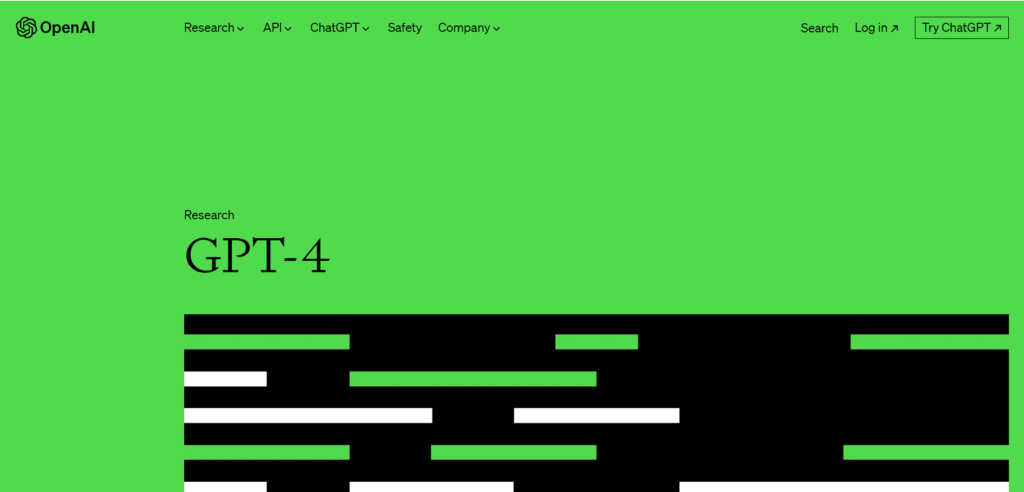
GPT-4
GPT-4, a substantial language model, is alternatively recognized as a conversational AI or chatbot that’s been trained to deliver comprehensive and informative responses. This AI entity has undergone extensive training on an extensive corpus of text data, equipping it to generate human-like text when presented with a diverse array of prompts and inquiries. For instance, GPT-4 is proficient at offering factual topic summaries and crafting narratives. Developed by the renowned name Open-AI it is one of the many tools developed by Open-AI, influencing the AI revolution, making it one of the best Generative AI Tools available.
GPT-4 Use Cases
Here are some examples of how GPT-4 can be used:
- Generating creative content: GPT-4 can be used to generate different creative text formats of text content, like poems, code, scripts, musical pieces, emails, letters, etc.
- Simplifying complex topics: GPT-4 can be used to simplify complex topics, like explaining new discoveries from NASA’s James Webb Space Telescope to a 9-year-old.
- Answering questions in an informative way: GPT-4 can be used to answer questions in an informative way, even if they are open-ended, challenging, or strange.
- Brainstorming ideas: GPT-4 can be used to brainstorm ideas and spark creativity.
- Accelerating productivity: GPT-4 can be used to accelerate productivity by performing tasks such as summarizing documents, generating reports, and creating presentations.
GPT-4 Features
Here are some of the features of GPT-4:
- Generative: GPT-4 can generate text, translate languages, write different kinds of creative content, and answer your questions in an informative way.
- Comprehensive: GPT-4 has access to a massive amount of information from the web and can use this information to provide comprehensive and informative responses to your questions.
- Informative: GPT-4 is trained to be informative and comprehensive and will try its best to provide accurate and helpful information in response to your questions.
- Safe: GPT-4 is designed to be safe and grounded in real-world information. It will not generate harmful or unsafe content.

Jasper
Jasper AI is a writing assistant driven by artificial intelligence (AI) that is adept at aiding you in the creation of top-notch content for diverse purposes, encompassing blog articles, social media updates, website copy, and email marketing initiatives. It leverages a sophisticated deep-learning language model to grasp your unique writing style and produce content that seamlessly blends informativeness and engagement.
Jasper AI Use Cases
Here are some examples of how Jasper AI can be used:
- Blog posts: Jasper AI can help you write blog posts that are informative, engaging, and SEO-friendly. It can provide suggestions for topics, titles, and headlines, as well as generate content for the body of your posts.
- Social media posts: Jasper AI can help you write social media posts that are short, sweet, and to the point. It can also generate suggestions for hashtags and images to include in your posts.
- Website copy: Jasper AI can help you write website copy that is clear, concise, and persuasive. It can also generate suggestions for calls to action and other elements that will help you convert visitors into customers.
- Email marketing campaigns: Jasper AI can help you write email marketing campaigns that are effective and engaging. It can generate subject lines, email body copy, and even personalized messages for your subscribers.
Jasper AI Features
Here are some of the features of Jasper AI:
- AI-powered writing assistant: Jasper AI uses a deep learning language model to generate content that is both informative and engaging.
- Variety of templates: Jasper AI offers a variety of templates for different types of content, including blog posts, social media posts, website copy, and email marketing campaigns.
- SEO-friendly content: Jasper AI can help you write content that is optimized for search engines.
- Plagiarism-free content: Jasper AI generates original content that is free of plagiarism.
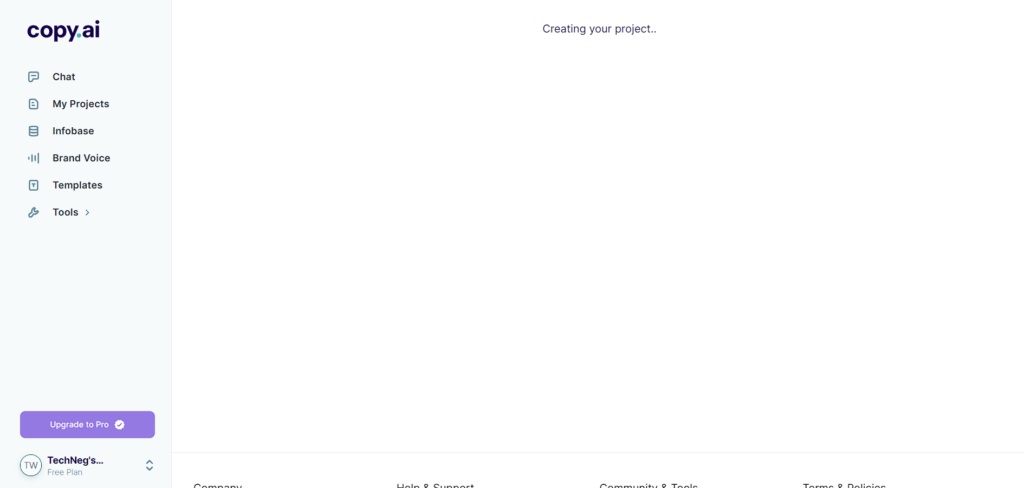
Copy.ai
Copy.ai is a copywriting tool empowered by artificial intelligence (AI), designed to assist businesses in crafting top-tier, compelling content for their marketing and sales endeavours. It utilizes a sophisticated deep-learning language model to produce text that is customized to meet the unique requirements of each individual business.
Copy.ai Use Cases
Copy.ai can be used for a variety of tasks, including:
- Generating website copy: Copy.ai can help you generate website copy that is clear, concise, and persuasive. It can also generate suggestions for calls to action and other elements that will help you convert visitors into customers.
- Writing blog posts: Copy.ai can help you write blog posts that are informative, engaging, and SEO-friendly. It can provide suggestions for topics, titles, and headlines, as well as generate content for the body of your posts.
- Creating social media posts: Copy.ai can help you write social media posts that are short, sweet, and to the point. It can also generate suggestions for hashtags and images to include in your posts.
- Crafting email marketing campaigns: Copy.ai can help you write email marketing campaigns that are effective and engaging. It can generate subject lines, email body copy, and even personalized messages for your subscribers.
Copy.ai Features
Copy.ai offers a variety of features to help businesses create high-quality copy, including:
- AI-powered writing assistant: Copy.ai uses a deep learning language model to generate text that is tailored to the specific needs of each business.
- Variety of templates: Copy.ai offers a variety of templates for different types of content, including website copy, blog posts, social media posts, and email marketing campaigns.
- SEO-friendly content: Copy.ai can help businesses generate content that is optimized for search engines.
- Plagiarism-free content: Copy.ai generates original content that is free of plagiarism.
- Long-form content generator: Copy.ai can generate long-form content, such as blog posts and articles, in a fraction of the time it would take to write them manually.
- Multiple languages: Copy.ai can generate content in over 25 languages.
Pros and Cons of Copy.ai

Wordtune
Wordtune is a writing assistant driven by artificial intelligence (AI), created to enhance your writing by enhancing its clarity, brevity, engagement, and persuasiveness. It leverages a range of methods, encompassing natural language processing, machine learning, and AI, to evaluate your writing and offer enhancements.
Wordtune Use Cases
Wordtune can be used for a variety of tasks, including:
- Editing and proofreading: Wordtune can help you edit and proofread your writing for grammar, spelling, and punctuation errors. It can also suggest stylistic improvements, such as making your writing more concise or engaging.
- Generating new content: Wordtune can help you generate new content, such as blog posts, articles, and social media posts. It can also help you brainstorm ideas and develop outlines.
- Translating languages: Wordtune can translate your writing into over 20 languages. It can also help you localize your writing for specific audiences and cultures.
Wordtune Features
Wordtune offers a variety of features to help you improve your writing, including:
- AI-powered writing assistance: Wordtune uses a variety of AI techniques to analyze your writing and suggest improvements.
- Real-time feedback: Wordtune provides real-time feedback on your writing as you type.
- Multiple writing styles: Wordtune supports multiple writing styles, including formal, informal, and creative.
- Tone detection and adjustment: Wordtune can detect the tone of your writing and suggest adjustments to make it more appropriate for your audience.
- Grammar and style correction: Wordtune can correct grammar, spelling, and punctuation errors in your writing.
- Plagiarism detection: Wordtune can detect plagiarism in your writing and suggest ways to avoid it.
Pros and Cons of Wordtune

Rytr
Rytr is an AI-powered writing assistant that helps you generate high-quality content for a variety of purposes, including blog posts, social media posts, website copy, and email marketing campaigns. It uses a deep learning language model to understand your writing style and generate content that is both informative and engaging.
Rytr Use Cases
Here are some examples of how Rytr can be used:
- Blog posts: Rytr can help you write blog posts that are informative, engaging, and SEO-friendly. It can provide suggestions for topics, titles, and headlines, as well as generate content for the body of your posts.
- Social media posts: Rytr can help you write social media posts that are short, sweet, and to the point. It can also generate suggestions for hashtags and images to include in your posts.
- Website copy: Rytr can help you write website copy that is clear, concise, and persuasive. It can also generate suggestions for calls to action and other elements that will help you convert visitors into customers.
- Email marketing campaigns: Rytr can help you write email marketing campaigns that are effective and engaging. It can generate subject lines, email body copy, and even personalized messages for your subscribers.
Rytr Features
Here are some of the features of Rytr:
- AI-powered writing assistant: Rytr uses a deep learning language model to generate content that is both informative and engaging.
- Variety of templates: Rytr offers a variety of templates for different types of content, including blog posts, social media posts, website copy, and email marketing campaigns.
- SEO-friendly content: Rytr can help you generate content that is optimized for search engines.
- Plagiarism-free content: Rytr generates original content that is free of plagiarism.
- Long-form content generator: Rytr can generate long-form content, such as blog posts and articles, in a fraction of the time it would take to write them manually.
- Multiple languages: Rytr can generate content in over 30 languages.
Pros and Cons of Rytr
More Generative AI Tools Available
Tips for Using Generative AI Tools Effectively
Generative AI tools can be a great way for writers, designers, and developers to boost their creativity and productivity. Here are a few tips for using them effectively:
1. Start small. Don’t try to use generative AI tools to do everything at once. Start by using them for a specific task, such as generating ideas for blog posts or designing new product ideas. Once you’ve gotten the hang of using them, you can start to experiment with more complex tasks.
2. Use multiple tools. There are many different generative AI tools available, each with its own strengths and weaknesses. Experiment with different tools to find the ones that work best for you.
3. Don’t just be a consumer. Generative AI tools are not magic bullets. They can generate creative ideas, but you still need to use your own judgment and skills to refine and implement those ideas.
Here are some specific examples of how writers, designers, and developers can use generative AI tools:
Writers
- Generate ideas for blog posts, articles, and other types of content.
- Edit and proofread your work for grammar, spelling, and punctuation errors.
- Translate your work into other languages.
- Write different kinds of creative content, like poems, code, scripts, musical pieces, emails, letters, etc.
Designers
- Generate ideas for new product designs, logos, and other graphic elements.
- Create prototypes of new products and designs.
- Test different design ideas with users.
- Generate design assets such as icons, images, and textures.
Developers
- Generate code for new software applications and features.
- Debug and test code.
- Generate documentation for code.
- Automate tasks such as writing unit tests and deploying code.
Generative AI tools represent a potent, innovative technology capable of enhancing the creativity and productivity of writers, designers, and developers. By adhering to the guidance provided above, you can harness the full capabilities of these tools.
However, it is equally crucial to remain cognizant of the potential drawbacks associated with the utilization of generative AI tools, including issues like bias and the dissemination of misinformation. Exercising responsible and ethical use of these tools is of paramount importance to mitigate any potential adverse consequences.

Ajay Kumar is an experienced author and the founder of Techneg.co.in, a platform dedicated to providing insightful content on technology






